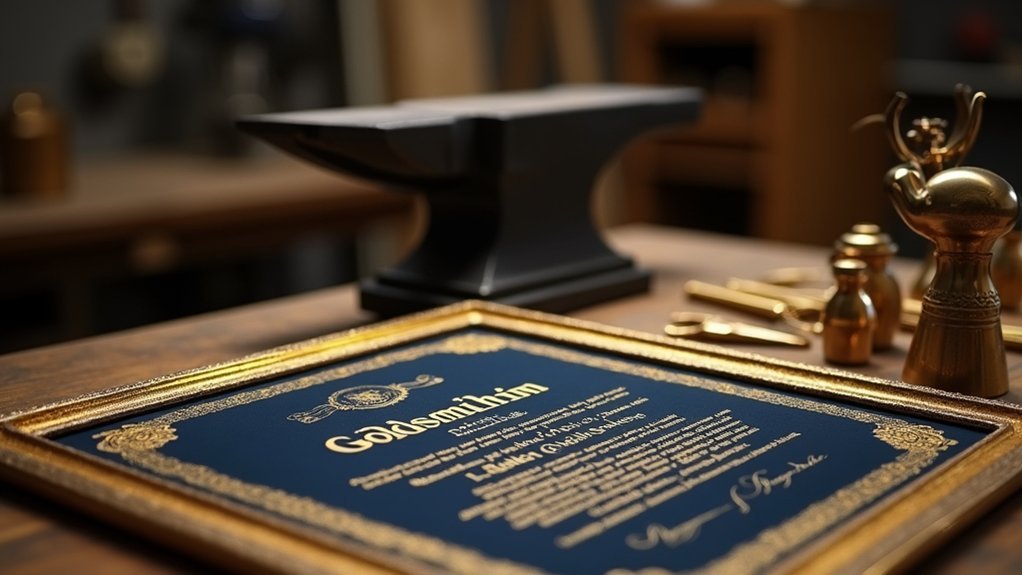You’ll need to complete a structured goldsmithing diploma program that combines hands-on metalworking techniques with essential business skills to launch your career in this prestigious craft. These programs typically last 1-2 years and cover metallurgy, design principles, jewelry repair, and gem setting while building a professional portfolio. You can choose from traditional apprenticeships, foundation courses, or degree programs, each offering different pathways to certification. This extensive guide will walk you through every option available to achieve your goldsmithing goals.
Understanding Gold Smithing Diploma Requirements

When you’re considering a Gold Smithing Diploma, you’ll need to complete a thorough program that combines theoretical knowledge with hands-on metalworking skills.
These programs typically span 1 to 2 years and cover essential subjects like metallurgy, design principles, jewelry repair techniques, and gem setting.
You’ll develop both technical skills and creative abilities through structured coursework and practical experience in workshops.
Many programs require you to have prior experience or complete foundational courses in jewelry making before enrollment.
Throughout your studies, you’ll work on hands-on projects that build your portfolio, showcasing your goldsmithing abilities to future employers or clients.
Financial aid options, including scholarships and grants, are often available at various educational institutions to help support your diploma pursuit.
Traditional Apprenticeship Programs for Gold Smithing
You’ll find that traditional apprenticeship programs like the Goldsmiths’ Company Scheme offer structured pathways into professional goldsmithing through hands-on workshop training.
These programs require you to commit to extensive practical hours while working toward recognized qualifications that’ll advance your career prospects.
You can expect to progress through different skill levels as you gain experience in real workshop environments under expert guidance.
Goldsmiths’ Company Scheme
Since goldsmithing apprenticeships represent one of the oldest forms of craft training, the Goldsmiths’ Company Apprenticeship Scheme continues this tradition by offering an extensive 3 to 5-year program that immerses you in authentic workshop environments.
This thorough scheme develops your practical skills through full-time work while building professional expertise.
Key program features include:
- Full-time commitment – You’ll work minimum 37.5 hours weekly in established goldsmithing workshops
- Structured education – Receive 19 days of day release training annually through accredited providers
- Progressive compensation – Start earning approximately £13,000, with salary increases throughout your development
You’ll need one year of prior work experience to qualify.
The program combines hands-on workshop training with formal education, leading to a level 4 qualification that positions experienced goldsmiths for successful careers in this specialized craft.
Training Workshop Requirements
Before you can begin your traditional goldsmithing apprenticeship, your chosen training workshop must meet specific standards that guarantee extensive skill development.
You’ll need to commit to a minimum of 37.5 hours per week in hands-on practical experience within an approved goldsmithing workshop. The workshop environment must provide thorough access to professional-grade equipment and materials necessary for metalworking and jewelry design projects.
Your training facility should support the integration of technical skills through structured project incorporation, allowing you to progress systematically through increasingly complex techniques.
Additionally, the workshop must collaborate with accredited colleges or training providers to facilitate your 19 days of annual day release education. This combination guarantees you’ll receive both intensive practical experience and theoretical knowledge required for your level 4 qualification in goldsmithing.
Qualification Level Progression
While traditional goldsmithing apprenticeships span 3 to 5 years, your qualification level progression follows a structured pathway that builds expertise systematically.
Through the Goldsmiths’ Company Apprenticeship Scheme, you’ll work toward a level 4 qualification while gaining hands-on experience in workshop settings.
Your qualification level progression includes:
- Practical Workshop Training – You’ll spend minimum 37.5 hours weekly in goldsmithing workshops, developing core metalworking and jewelry design skills.
- Academic Development – You’ll receive 19 days annual day release training at colleges or training providers to support your qualification advancement.
- Experience Requirements – You’ll need at least one year of relevant work experience before starting traditional apprenticeships.
This progression guarantees you’re equipped with essential skills for successful goldsmithing careers.
Trailblazer Apprenticeship Opportunities
Though traditional apprenticeships have evolved greatly, Trailblazer Apprenticeship Opportunities in goldsmithing offer you a structured pathway to master this ancient craft through modern training standards.
This apprenticeship program takes approximately two years to complete and leads to a level 3 vocational qualification. You’ll gain practical skills and industry knowledge while earning wages that typically increase from £13,000 initially to around £18,000 upon completion.
The Institute for Apprenticeships and Technical Education has approved the Trailblazer Framework for Jewellery, Silversmithing, and Allied Trades, specifically designed for England and Wales.
Aspiring goldsmiths need to demonstrate genuine interest in the craft and willingness to learn from experienced professionals. Organizations like the British Academy of Jewellery and City & Guilds provide information about available opportunities and training providers.
Foundation and Introductory Course Options

Since apprenticeships aren’t the only pathway into goldsmithing, Foundation and Introductory Course Options provide you with structured academic alternatives that typically span one to two years.
These foundation courses help you build a thorough portfolio of skills while introducing various industry aspects.
You’ll find several advantages with these programs:
- Nationally recognized qualifications that enhance your career advancement opportunities
- Specialized bench skills training combined with related technologies and techniques
- HND course availability equivalent to the first two years of a Bachelor’s Degree
Institutions like Birmingham City University School of Jewellery offer tailored programs for aspiring goldsmiths.
While fees vary, learner loans might be available to support your studies, making these courses accessible pathways into professional goldsmithing.
Degree Programs in Jewelry Design and Metalworking
When you’re selecting a degree program in jewelry design and metalworking, you’ll need to evaluate factors like program length, specialization options, and career outcomes.
Most programs span 2 to 4 years and focus on core skills including metal design, studio art, and creative problem-solving techniques.
You should examine each program’s curriculum to verify it covers precious metals work, fabrication methods, and modern technology applications that align with your professional goals.
Program Selection Criteria
How do you identify the right degree program in jewelry design and metalworking for your goldsmithing aspirations? Your program selection criteria should focus on three essential elements that’ll determine your success in the field.
- Comprehensive metalworking departments – You’ll need access to well-equipped facilities and experienced instructors who can provide thorough training in metal fabrication, stone setting, and mold making techniques.
- Hands-on curriculum structure – Look for programs emphasizing practical studio work alongside courses in metal design, studio art, and communications that develop both technical and business skills.
- Career alignment and support – Verify the program matches your goals, whether you’re pursuing goldsmithing, jewelry design, or visual arts.
Research available financial aid and scholarships specifically for art students to manage costs effectively.
Academic Curriculum Overview
Once you’ve selected the right program, understanding what you’ll actually study becomes your next priority. The academic curriculum in jewelry design and metalworking programs spans 2-4 years, combining theoretical knowledge with intensive hands-on training. You’ll master essential techniques including fabrication, stone setting, and metal casting while developing your artistic vision through studio art courses.
| Core Skills | Technical Methods | Business Applications |
|---|---|---|
| Metal Design | Fabrication | Communications |
| Studio Art | Stone Setting | Portfolio Development |
| Creative Process | Metal Casting | Industry Preparation |
Your coursework culminates in creating a professional portfolio showcasing your skills and creativity. This thorough approach prepares you for diverse career paths as a jeweler, goldsmith, silversmith, or jewelry business owner, with options for associate or bachelor’s degree completion.
Skill-Specific Training for Diamond Grading and Gemmology

Although goldsmithing traditionally focuses on metalwork, you’ll find that diamond grading and gemmology skills greatly enhance your expertise and marketability in the jewelry industry.
Specialized training in gemology and precious stones evaluation requires completing courses from recognized institutions like the Gemmological Institute of America or the Gemmological Association of Great Britain.
Professional gemology certification from established institutions like GIA or Gem-A provides the credibility and expertise essential for serious jewelry professionals.
These extensive programs provide:
- Hands-on experience with various gem materials, focusing on the four Cs: color, clarity, cut, and carat weight
- Practical assessments using industry-standard tools to grade diamonds and authenticate precious stones
- Industry-recognized qualifications that enable you to assess gemstone quality and provide accurate valuations
You’ll need ongoing professional development and industry membership to stay current with evolving technologies and discoveries in gemology.
Short Course Benefits for Professional Development
While mastering core goldsmithing techniques forms your foundation, short courses offer a strategic pathway to sharpen specific skills and advance your professional development without the extensive commitment of full diploma programs.
You’ll find these courses range from just a few hours to weekly sessions, making them perfect for busy professionals seeking targeted skill enhancement.
Short courses let you explore specialized techniques like oxidisation methods or material properties that keep you competitive in today’s market.
Whether you’re a beginner or experienced craftsperson, these programs accommodate various skill levels through hands-on workshops.
You’ll gain practical experience while staying current with industry trends and techniques, all while making minimal time and financial investments in your professional development journey.
Financial Aid and Scholarship Opportunities

You’ll find several funding sources available for your goldsmithing diploma, including federal grants, scholarships, and loans accessible through FAFSA or WASFA forms.
Many institutions offer art-specific scholarships for jewelry design students, while industry organizations provide additional funding opportunities based on financial need or exceptional talent.
To maximize your chances of securing aid, you should complete applications early, verify current funding information directly with training providers, and explore whether potential employers might cover your training costs.
Available Funding Sources
Since goldsmithing education can be a significant investment, you’ll want to explore the various funding sources available to help make your diploma more affordable.
Multiple financial aid options exist to support your artistic education journey.
Here are three primary funding sources to evaluate:
- Federal and State Aid – You can apply through FAFSA or WASFA for financial aid that supports both full-time and part-time goldsmithing students.
- Art-Specific Scholarships – Various organizations offer scholarships specifically designed for art students, helping cover tuition costs for eligible applicants pursuing creative disciplines.
- Work-Study Programs – Many colleges provide work-study positions that let you gain hands-on experience while earning money to offset educational expenses, creating valuable networking opportunities within your field.
Application Process Tips
Although financial aid applications can seem overwhelming at first, breaking down the process into manageable steps will help you secure funding for your goldsmithing diploma. Start by completing your FAFSA or WASFA forms early to establish eligibility for grants and loans. Research art-specific scholarships immediately, as deadlines vary considerably.
| Application Step | Timeline |
|---|---|
| Complete FAFSA/WASFA | October-December |
| Research scholarships | 6 months before enrollment |
| Contact financial aid office | 3-4 months before enrollment |
| Document portfolio work | Throughout program |
Contact your institution’s financial aid office to discover unique goldsmithing program opportunities. Document all classwork and participate in art sales to strengthen scholarship applications. Work-study positions offer both financial assistance and practical experience, making them valuable funding sources worth pursuing early.
Core Curriculum and Hands-On Training Components
Anyone pursuing a goldsmithing diploma will encounter an extensive core curriculum that blends theoretical knowledge with intensive hands-on practice.
You’ll study metal design, jewelry fabrication, stone setting, and gemology to build a thorough foundation in the craft.
The hands-on training components focus on practical workshops where you’ll master essential techniques:
- Technical Skills Development – You’ll learn soldering, casting, and polishing methods to create finished jewelry pieces.
- Custom Design Projects – You’ll complete assignments demonstrating your ability to design and execute original jewelry, enhancing both technical abilities and creative expression.
- Real-World Experience – Many programs offer day-release training opportunities, allowing you to gain workshop experience while pursuing qualifications.
Assessment combines practical craftsmanship evaluations with theoretical examinations covering materials science and design principles.
Career Pathways After Diploma Completion

Upon completing your goldsmithing diploma, you’ll find diverse career opportunities waiting across the jewelry industry and beyond.
A goldsmithing diploma unlocks numerous career paths throughout the jewelry industry and creative arts sectors.
Traditional career pathways include becoming a jeweler, gold/silversmith, stone setter, or jewelry business owner. Your diploma opens doors to specialized areas like gemology, where additional certifications boost your earning potential.
You can pursue further education through an Associate of Fine Arts Degree at institutions like North Seattle College, enhancing qualifications for advanced positions.
The industry extends beyond traditional jewelry making, offering roles as art handlers, practicing studio artists, or even teaching positions.
Networking through workshops and events proves invaluable, connecting you with established studios and businesses that offer internships or job placements in this creative field.
Industry Certification Bodies and Accreditation
Professional certification bodies play an essential role in validating your goldsmithing expertise and enhancing your career prospects.
Industry certification bodies like the British Academy of Jewellery and City & Guilds offer recognized qualifications that notably boost your credibility with employers. Accreditation from these organizations demonstrates your commitment to professional standards and can lead to higher salaries.
Key certification options include:
- British Academy of Jewellery – Provides thorough goldsmithing qualifications recognized throughout the industry.
- City & Guilds – Offers technical certifications that employers actively seek when hiring.
- Gemmological Association of Great Britain – Specializes in gemology accreditation for jewelry makers.
The Institute for Apprenticeships and Technical Education oversees Trailblazer Apprenticeships, ensuring training relevance.
Continuous professional development through accredited workshops keeps your skills current with market demands.
Portfolio Development and Practical Assessment
Building a compelling portfolio serves as your professional calling card in the goldsmithing industry, demonstrating both technical mastery and creative vision to potential employers or clients.
Portfolio development should showcase diverse pieces you’ve created throughout your training, highlighting various techniques and styles you’ve mastered.
A well-curated portfolio displays your technical range and artistic growth, proving your versatility across multiple goldsmithing disciplines and approaches.
Your practical assessment typically involves creating specific jewelry items or demonstrating learned techniques to evaluate your craftsmanship and skill proficiency.
Educational programs guide you through effective presentation methods, ensuring your work stands out in competitive markets.
You’ll enhance your portfolio quality through continuous learning via workshops and short courses, incorporating new techniques and materials.
Your diploma completion requires both theoretical knowledge and practical assessments, guaranteeing you’re well-rounded before entering the workforce professionally.
Transitioning From Student to Professional Goldsmith
Although your diploma marks a significant educational milestone, evolving from student to professional goldsmith requires strategic planning and deliberate action. Your goldsmithing education provides essential skills in jewelry design, metalworking, and gemology that’ll serve as your foundation.
To successfully shift into the industry:
- Secure an apprenticeship lasting 3-5 years for hands-on experience and mentorship from established professionals.
- Build diverse portfolio showcasing various techniques and styles to attract potential employers or clients.
- Network actively through workshops and industry events to connect with professionals and discover job opportunities.
Continue developing your skills through post-diploma courses and workshops. This keeps you current with industry trends and enhances your career prospects.
Your diploma opens doors, but strategic action transforms educational achievement into professional success.
Frequently Asked Questions
Do You Have to Go to School to Be a Goldsmith?
You don’t need formal schooling to become a goldsmith. You can learn through apprenticeships, self-teaching with online resources, or taking specific skill courses. However, completing a degree improves your job prospects considerably.
How Hard Is It to Become a Goldsmith?
Becoming a goldsmith requires significant dedication and time investment. You’ll need 3-5 years for apprenticeship plus prior experience, or 2-4 years for formal education. Self-teaching takes even longer to achieve proficiency.
Is Goldsmith a Good Career?
You’ll find goldsmithing rewarding if you’re passionate about craftsmanship and creativity. Starting salaries reach £13,000-£18,000, with diverse career paths available. You’ll need patience, skill development, and dedication to succeed in this specialized trade.
What Is the Difference Between a Goldsmith and a Jeweler?
You’ll find that goldsmiths specialize in working with precious metals and focus on technical fabrication, while jewelers have broader responsibilities including sales, design, and working with various materials beyond just gold.
In Summary
You’ve now explored every pathway to earning your goldsmithing diploma, from traditional apprenticeships to modern degree programs. You’ll need to choose the route that matches your learning style and career goals. Don’t forget to build a strong portfolio and seek proper accreditation from recognized industry bodies. With dedication and the right training, you’ll transform from student to skilled professional goldsmith, ready to craft your future in this timeless trade.





Leave a Reply